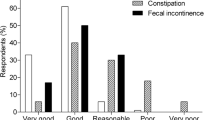Abstract
PURPOSE: We are interested in the way patients, who underwent surgery for high anorectal atresia, control their defecation. Considering that some patients, despite newer operative techniques, always will suffer from minor or major soiling we attempted to find some guidelines for postoperative support for future patients. METHOD: Fifty-eight patients (median age, 26 (range, 18.1–56.9) years) were personally interviewed. RESULTS: Regulating defecation is done in five different modes: 16 patients have stools after urge, 15 control their stools mainly by going to the toilet at regular times, 18 perform bowel-irrigations or use enemas, 2 have loss of feces continuously, and 7 patients have an ileostomy or colostomy. More than one-half of patients influence their defecation by diet. Of the patients with anal defecation, 6 never soil, 39 sometimes soil small amounts, and 6 often soil seriously. Eighteen patients occasionally suffer from constipation. There is no mode of defecation regulation outstanding in preventing soiling or constipation. However, patients who do not regulate defecation somehow suffer from serious soiling. Most patients are content with their level of cleanliness. CONCLUSION: Irrespective of the mode of defecation regulation, many patients soil sometimes small amounts and a few often soil seriously. In view of the fact that most patients had to find the current control of defecation regulation by themselves rather late and lacked professional support, it is questionable whether the chosen mode of defecation regulation is the most optimal mode for each patient. We assume that a stepwise protocol under professional support, starting by the most natural mode of defecation, will improve defecation regulation in a more efficient way (earlier and better).
Similar content being viewed by others
References
Hassink EA, Rieu PN, Severijnen RS, Staak vd FH, Festen C. Are adults content or continent after repair for high anal atresia? A long-term follow-up study in patients 18 years of age and older. Ann Surg 1993;218:196–200.
Langemeijer RA, Molenaar JC. Defaecation problems in children: anatomy, physiology and pathophysiology of the defaecation mechanism. Neth J Surg 1991;43:208–12.
Stephens FD, Smith ED. Anorectal malformations in children: update. New York: Alan R Liss, 1988.
Long L, Zheng L, Lian-Ling W, Fu-Da X. Anorectal anomaly: neuropathological changes in the sacral spinal cord. J Pediatr Surg 1993;28:880–5.
Largo RH, Gianciarusa M, Prader A. Die entwicklung von darm und blase kontrolle von der geburt bis zum 18 lebensjahr. Schweiz Med Wochenschr 1978;108:155–60.
Vandvik HV, Ødegaard B. Practical and emotional aspects of soiling in children with anorectal anomalies. Eur J Pediatr 1981;33:321–9.
Shepherd K, Hickstein R, Rose V, Nasser C, Cleghorn GJ, Shepherd RW. Faecal incontinence in childhood: a multidisciplinary approach including biofeedback. Aust Paediatr J 1989;25:351–5.
Peña A. Harry E. Bacon Lectureship. The posterior sagittal approach: implications in adult colorectal surgery. Dis Colon Rectum 1994;37:1–11.
Squire R, Kiely EM, Carr B, Ransley PG, Duffy PG. The clinical application of the Malone antegrade colonic enema. J Pediatr Surg 1993;28:1012–5.
Toogood GJ, Bryant PA, Dudley NE. Control of faecal incontinence using the Malone antegrade continence enema procedure: a critical appraisal. Pediatr Surg Int 1995;10:37–9.
Nixon HH, Puri P. The results of treatment of anorectal anomalies: a thirteen to twenty year follow-up. J Pediatr Surg 1977;12:27–37.
Rintala R, Lindahl H, Louhimo I. Anorectal malformations—results of treatment and long-term follow-up in 208 patients. Pediatr Surg Int 1991;6:36–41.
Peña A. Posterior sagittal anorectoplasty: results in the management of 332 cases of anorectal malformations. Pediatr Surg Int 1988;3:94–104.
Baeten CG, Konsten J, Heineman E, Soeters PB. Dynamic graciloplasty for anal atresia. J Pediatr Surg 1994;29:922–5.
Author information
Authors and Affiliations
Additional information
Supported by the Foundation of Pediatric Surgical Research of the University Hospital, Nijmegen, The Netherlands.
About this article
Cite this article
Hassink, E.A., Rieu, P.N., Severijnen, R.S. et al. Adults born with high anorectal atresia—How do they manage?. Dis Colon Rectum 39, 695–699 (1996). https://doi.org/10.1007/BF02056953
Issue Date:
DOI: https://doi.org/10.1007/BF02056953




